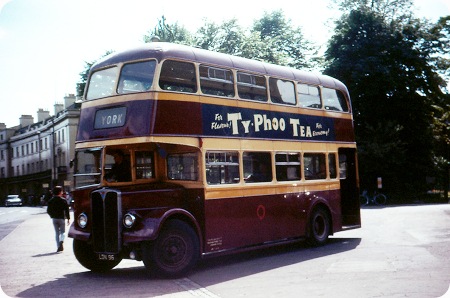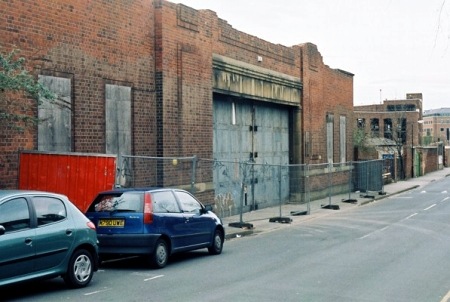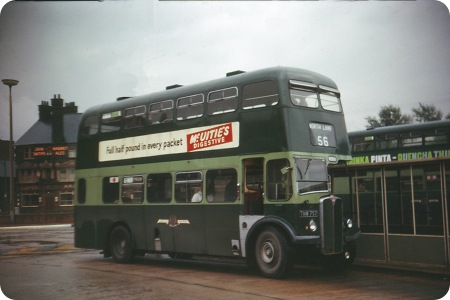
Liverpool City Transport
1950
AEC Regent III
Weymann H??R
This bus is pre 1951 because all buses in the Liverpool fleet after that date were 8ft wide and had two side by side destination boards with route numbers above a quick link here to view an example. The bodies were supplied from Weymann as frame only they were then finished by Liverpool Corporation in their own body shops.
When new, this bus DID have 2 cream bands, one below the upper windows and the other above the lower windows – most were repainted in the early 60s as above.
Anonymous
I remember these as being quite fast and manoeuvrable, with their pre-selector gearboxes and distinctive sound. Two particular memories – one, hearing and seeing them thundering along the Strand and Goree on the heavily trafficked 1 route between Dingle and Seaforth (the bus route which effectively replaced the overhead railway) and two, being upstairs on the peak workings of the 71 between Penny Lane and I think South Castle Street, upper deck thick with tobacco fug and not a seat to spare. On full return journeys buses were able to avoid the congested city centre and skirt up the hill past the cathedral non-stop,
Anonymous
04/05/12 – 08:52
I remember driving one on a road that was VERY BENDY and went through Woolton Golf course and it was far easier than the usual AEC MK Vs we usually used. It took the bend’s beautifully.
Dave
10/10/13 – 15:51
I worked at Walton garage as a conductor and driver and I have fond memories of the number 1 route Seaforth to Dingle with a full bus of Dockers on board going to work at various docks along the Liverpool waterfront
Billy
17/04/15 – 07:04
One thing I never could understand was how the pre-selector gearbox worked…can anyone post a simple, not too technical explanation?
Mr Anon (lpl)
18/04/15 – 07:30
Here is a link to a detailed explanation.
Peter
19/04/15 – 07:31
Not many folk realise that something that many of were familiar with, when we were young, was an epicyclic gearbox; namely the Sturmey-Archer bicycle rear wheel hub, a compact gem of genius, IMHO.
Chris Hebbron
19/04/15 – 07:31
One thing that needs to be added to the article in Peter’s link is that on postwar AECs the change speed pedal operated by compressed air rather than a spring.
Peter Williamson
19/04/15 – 11:52
Guy also offered the Arab III with an air operated preselector gearbox.
Roger Cox
20/04/15 – 07:13
As usual I’m late to the party, but I thought I might as well jump on the (pre-selector) bus anyway. In previous threads contributors have written about the Daimler quadrant pre-selector selector. I’ve been puzzled as to how that worked, as opposed to a conventional selector gate, but never thought to ask . . . anybody out there care to enlighten me?
Sturmey-Archer gears = Raleigh Chopper! Pennant on the back? Tassels from the handlebars?? Playing card clothes-pegged to the rear fork to give that "motorcycle" sound??? Not me! – too sophisticated (me, not the Chopper kids) – 15sp Derailleur for me (even if I only ever used about five). But I remember the arguments in the playground as to whether one should pedal/stop pedalling/back-pedal when changing Sturmey-Archers . . . did it matter?
Philip Rushworth
21/04/15 – 06:27
To the best of my memory, the quadrant went RN1234, from nearest the driver outwards. At least LT’s CWA/CWD’s did.
Chris Hebbron
21/04/2015 06:28:26
Philip, the quadrant selector simply moved in a continuous arc as may be seen in this picture:- www.flickr.com/photos/superkevs/
One had to be careful to set the lever accurately in preselecting the next gear, or the pedal would spring back with some vehemence. The gate type selector used by AEC on the Regent III was much more positive. Earlier AEC and some Guy preselectors used a selector that looked like a conventional gear lever. Take a look at this page:- www.flickr.com/photos/preselector
Sturmey Archer bicycle gears – yes, you should stop pedalling when changing gear. The engagement of each epicycle gear is made by means of a rod (equivalent to the band brake on a bus gearbox) that locks each gear through the spindle. Keep pedalling, and you will chew it up and burr the matching gear internals to bits.
Roger Cox
21/04/15 – 09:44
Did the position of the Daimler gear-change vary even on the same model? My memory of the Portsmouth Daimler CWA6’s was of the gear select on the left side. The first link supplied by Roger shows it at the right side. As delivered, both the Portsmouth ones, and the Douglas one in the link would have been "identical", of the CWA6 variant, and with Duple bodies. (The Portsmouth ones were rebodied in 1955 by Crossley, and appear elsewhere on this site). Perhaps my memory is incorrect, any comments welcome.
Michael Hampton
22/04/15 – 07:30
Roger, thanks for the informative post – exploring the links has filled up time why my class completed a mock examination.
Philip Rushworth
22/04/15 – 07:30
On Portsmouth’s rebuilt-bodied CWA6’s, the quadrant was definitely on the R/H side, Michael H. Never looked inside the cab of them in their original form.
Chris Hebbron
22/04/15 – 07:31
Wonderful picture Roger, (& Kev) of the cab of a Daimler CV/CW! I don’t think the CV was any less primitive. Would suit someone with strong arms and small feet. Good through-flow ventilation, too. Daimler (and others) never felt the need to promote their vehicles once sold- the fluted (often painted) radiator and a couple of D bosses on the front wheels (possibly?) were the only indicators. Leyland seemed to encourage you to put your own badge on the radiator, too. That all changed with the bustle buses with huge flutes, Atlas et al, although Leyland had rarely anything to put on the front of an Atlantean, unlike the St Helens front. Enough rambling: I think the quadrant was on the right on a CV?
Joe
23/04/15 – 07:02
Thanks Chris H for confirming the quadrant position. Clearly my memory is playing tricks! I only remember these in their rebodied form, even though I lived in the area when they were in original condition.
Michael Hampton
23/04/15 – 07:03
Manchester’s and Derby’s CAVs were certainly on the right Hand side. I have never driven nor seen one with it on the left.
Because the settings used to wear, the gear was never where the mark was on the quadrant, so Drivers used to put pencil marks on it. There were that many marks on them, you still never knew where it was.
You then used to put your own Mark on adding to the confusion.
I loved driving pre-select buses, they also made you read the road, having the correct gear selected was important to keep up steady and speedy progress.
BUT watch out for the pedal kicking back, it did hurt, OUCH.
Stephen Howarth
23/04/15 – 08:32
Roger wrote :-
"One had to be careful to set the lever accurately in preselecting the next gear, or the pedal would spring back with some vehemence."
Roger, that’s definitely the finest and most eloquent description of the dangerous fault exhibited by the spring operated gearboxes that I’ve ever heard. the problem was, of course, even worse as not only did the pedal spring back with the vehemence mentioned but also came considerably further out than was the norm, which is how the pain and often injury occurred.
Incidentally it was also necessary to raise a button to allow the quadrant lever to travel beyond neutral to select reverse. A further pitfall for fresh or inattentive drivers was to set off with gusto in first gear and to fail to preselect second gear – then a little later when correctly allowing the engine revs to die down before letting the pedal out you were likely to find the passengers and conductor trying to join you in the cab – the violent braking effect thus achieved would have given a very favourable reading on the Tapley Meter brake tests !!
Chris Youhill
24/04/15 – 06:25
Chris Y, we have obviously both suffered the less than tender mercies of the spring operated preselector when not treated precisely in accordance with ‘the book’. One could always pick out the casualties by their progress round the depot in their accurate impressions of Laurence Olivier in the role of Richard III. The pedal would come back twice as far as normal with the force of all the springs in the box (or so it seemed) generally thrusting one’s left knee into violent contact with the steering column. I wonder how modern companies would get on with such a gearbox in this age of compensation culture and ambulance chasing litigators. Your vivid description of the outcome of a lapse of memory in not preselecting the next upward gear is something that I must put my hand up to having enacted occasionally. The ensuing ‘g’ forces restored one’s concentration at lightening speed, so that one shoved and held the gear pedal down instantly. Ah, happy, joyous days. The modern crop of bus steering wheel attendants don’t know what a gearbox is.
Roger Cox
24/04/15 – 06:26
You have conjured up a wonderful image of said passengers and conductor crammed into the cab with the driver Chris! Very descriptive, and it made me chuckle. I’m sure I read somewhere in the distant past, that the height of the gearchange pedal on some buses with spring-operated preselector gearboxes varied, dependent on which gear the vehicle was in. Is this correct, or is it, to quote Hylda Baker "a figleaf of my imagination?"
Brendan Smith
24/04/15 – 08:47
Brendan Smith you are correct in thinking that the ‘Change speed pedal’ (sometimes referred to as ‘The Tripper pedal’), was at different heights depending on which gear it was in. Lowest being neutral, and highest being top, in normal driving.
Not only was your knee jammed under the steering wheel but your heel was stuck under the seat frame. This along with your foot held on the pedal, made it virtually impossible to apply any pressure to push the pedal down against the 5 springs. Hence the need of outside assistance in returning it to the normal settings.
At Derby we had a Driver called ‘Tripper Wood’ so named because he had been kicked by the pedal so many times, he used to slide his foot off quickly to avoid such occurrences.
He gave a very rough ride, but had a regular mate, who, I guess was used to his driving style.
Stephen Howarth
25/04/15 – 09:23
There was just one ray of hope in the spring operated "kick back" scandal. If you were lucky enough to survive without injury to the ankle, and your foot was not trapped, it was usually possible to apply both feet to the extended pedal while heaving the shoulders against the cab rear window area – first of course making sure to positively select neutral. This usually worked, although Goodness knows what the passengers must have thought to the performance !!
Chris Youhill
26/04/15 – 07:48
For completeness I should add that later CVGs had a gear selector gate on the left, very similar to the one on the Regent III. Later still, when air brakes were offered, the gearbox could be either Daimatic (like the Fleetline) or air-operated preselect like the Regent III. But the spring-operated type continued to the end on vacuum-braked chassis.
Peter Williamson
28/04/15 – 06:59
Thanks for confirmation of the gearchange pedal positioning Stephen, and your reference to "tripper pedal" which I have not heard before, but is a very descriptive phrase. I had read that drivers’ knees were prone to a severe blow if the pedal kicked back, and Roger and Chris Y have also mentioned this, but how many of us realised that a driver could end up trapped with his knee under the steering wheel and heel under the seat frame? It sounds absolutely scandalous that such events could be deemed acceptable by manufacturers and operators alike, and must have led to severe bruising, and in extreme cases to fractures and torn ligaments/tendons, which are no laughing matter. On a lighter note however, Roger’s comment about injured drivers doing impressions of Richard III raised a chuckle. Presumably they would have preferred the RT’s air-operated system, but its only a hunch…..
Brendan Smith
23/01/17 – 07:33
As a child I recognised these AEC Regents which dominated route 1 from 1957 to 1967.
Route 1 was the last route to employ 7ft 6 ins wide buses full time. The 1 allocation was drawn from the ranks of 9.6 litre preselector buses A325-349, later A525 etc, and A657-756. When route 1 started the roads in the south docks were unsuitable for buses and it was not until autumn 1958 that the council paved the Dingle area roads. The route north of the Pier Head had similar problems but a parallel route was adopted for the 1 which was not too far from the docks.Buses replacing the Overhead Railway had three problems, paving being one but the others were the need for the buses to climb Dingle Mount whereas the LOR burrowed through the cliffs, which meant the powerful 9612Es were essential for the task. The other obstacle was Stanley Dock Bridge which, 7′ 6" wide buses could pass each other but not wider buses. This was not resolved till the 1990s and so when the narrower buses were withdrawn during 1967/68 buses had to take turns to cross the bridge. The 1 route, under Merseyside PTE a shadow of its former self as a frequent route vanished on deregulation in 1986. Some extracts of this sourced from Liverpool Transport Vol. 4 1939-57 by Messrs Horne & Maund.
Paul Mason




